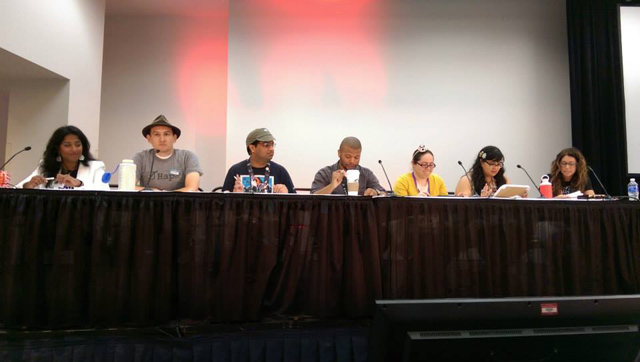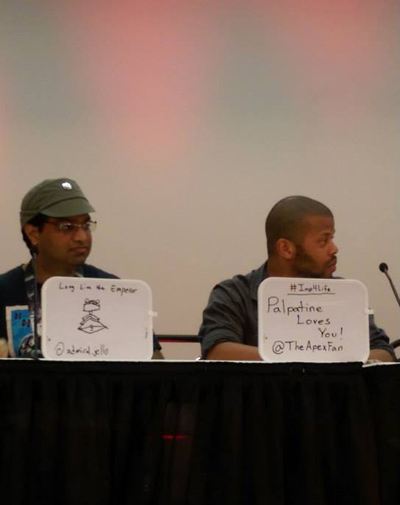
Star Wars Celebration Anaheim was a rousing success by most metrics: it set attendance records, the media coverage was 24/7, it had an unprecedented livestream, and fans emerged energized and excited for the new Star Wars films. We had a great time at Celebration, and we propose another metric for the great success of Star Wars Celebration Anaheim: the growth of Star Wars by leaps and bounds into a truly universal community.
To be sure, Star Wars always had near universal appeal (that’s how we all became fans, after all). But Tricia Barr – who hosted the “From a Certain Point of View” panel that we were honored to be part of – said it best: this Celebration was perhaps the most diverse yet, even considered in terms of the people who were on that very panel. Kathleen Kennedy made a great and very well-received statement about Star Wars finally recognizing its female fan base and striving hard to have that recognized on-screen (as it’s starting to be recognized on the page). Many attendees expressed surprise at how well-attended the convention was, both in absolute numbers (something like 60,000 people) and in the geographic representation of the audience. We saw many people who had flown in from Europe, Latin America, and Asia. We saw small children, teenagers, adults, and older folks.
Anyone who thinks that Star Wars is just for a certain demographic, whether a younger-skewed age group or exclusively males, should come to a Star Wars Celebration and realize that Star Wars is for everyone. It always has been, but Celebration Anaheim really drove the point home (and here we hear echoes of “Chewie, we’re home,” the Celebration mantra in more than one way). With the welcome diversity in the novels/comics, Rebels, and now the films it’s become absolutely clear that Star Wars has finally recognized that it is for everyone. Some might ask why this kind of representation matters, if Star Wars already had that universal appeal – well, read on and we’ll tell you why it’s so important.
Being Part of That World
We’d be preaching to the choir if we explained what makes Star Wars so attractive to its fans. Star Wars has fired up the imagination of children and adults for decades, and for good reason. Yet for the longest time, there was only one female main character and one main character of color. Even when expanding the scope to secondary and tertiary characters, the same proportion remains. Female pilots were cut out of Return of the Jedi, and it took until the prequels to get more minority characters on screen (with awkward racial stereotyping cutting against any sense of progress). We often see people refer to minority representation as fitting quotas or being politically incorrect, and we’d like to explain why that’s wrong-headed.

As we’ve illustrated, the Star Wars audience is pretty diverse these days and arguably has been for a while. People from places near and far enjoy Star Wars, and nobody can attend a Star Wars Celebration and repeat the absurd dictum that “girls don’t like Star Wars.” Sorry, it’s just not true. Luke, Han, and Leia are great role-models for everyone. As a kid, Princess Leia was our favorite character along with the EU’s Jaina Solo (even after we saw the light and became an Imperial fan, adding Darth Vader to that list). We know plenty of women who were fans of Luke or Han growing up, and we mean in the sense of idolizing and idealizing too. The characters have enough going for them that things like gender aren’t really an obstacle.
Sometimes people identify strongly with characters who don’t look like them. There were plenty of female Han Solo and Luke Skywalker cosplayers at Celebration, and some male Leias too. We saw an African-American Leia and an Asian-American Han Solo as well. Everyone’s a fan, even though some might tut-tut that they don’t look like the characters they’re costuming as – but why would someone begrudge someone their fun and fandom?
Kathleen Kennedy gets it, though. She pointed out that for the longest time, female fans only had Leia to look at in terms of a strong main character that they could see themselves in. Princess Leia did a lot of the heavy lifting in the early days of the fandom, and there was an excellent panel where male and female fans expressed their appreciation for her trailblazing. Now times have changed, and the future looks good. Rebels alone features female and minority characters galore, and the new books and upcoming movies are looking wonderful in that regard. We can’t express how great it was to see little kids dressed as Hera, Sabine, Kanan, or Ezra. Kids are so excited to see these characters, and they mean a lot to older fans too. People who’ve been fortunate enough to always have characters reflect how they see themselves might not understand what it’s like.
Sometimes we hear people ask why a character looks a certain way, whether in terms of race or gender. Is there a good story reason to make Kanan look Hispanic, is there a plot purpose behind Sabine looking Asian? That seems like the silliest question to us, like walking up to a Hispanic or Asian person and asking them to justify why they exist. And by silly we mean pretty darn offensive, don’t let the politesse fool you. A Star Wars whose cast resembles the makeup of reality isn’t Political Correctness or pandering, it’s just recognition of the incredible breadth and diversity of reality and it’s about time the canon reflected the global nature of the fandom. This can only be a good thing, despite the concerns about “quotas” and such (concerns we find to be unwarranted, as our conversation with Jason Fry at Celebration indicates that there is no diversity directive from on high, but that creators in all aspects of Star Wars have recognized the incredible diversity in the audience). Diversity will not hurt anyone.
In fact, we sometimes hear people tell us that they can’t enjoy a book, show, or video game where the protagonist doesn’t look like they do. That seems strange to us, because imagination is a basic part of fiction: relating to different sorts of characters. But it seems stranger because those people miss that for the longest time, many people had to make do with Star Wars characters that had little resemblance to themselves. We all coped and were all Star Wars fans regardless: so we say, it’ll be okay, we promise! Male or female, black or white, everyone cheered when Han came on screen during the trailer: we fondly hope that Rey, Finn, and Poe Dameron all have the same resonance with fans regardless of who they are and what they came from.
